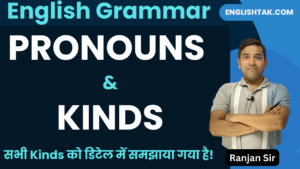![]()
Prepositions in English Grammar in Hindi
Table of Contents
Prepositions in English Grammar in Hindi – In English, prepositions help us build sentences. There are over 100 prepositions, but some of the most common are “in,” “at,” “on,” “under,” “beside,” and “between.” This post will explain what prepositions are, how to use them, and what they mean. We’ll include examples to show how prepositions work in sentences. Let’s start learning about prepositions!
Join Our Group
Prepositions in English Grammar in Hindi
Use of In and After:
In is used to indicate a period of time in the future, while After indicates when an action will be completed.
Examples:
I shall do the work in a week.
मैं एक सप्ताह में काम पूरा कर दूंगा।
I shall do the work after a week.
मैं एक सप्ताह के बाद काम पूरा कर दूंगा।
Use of In and At:
At is used for small places, while In is used for larger cities and countries.
Examples:
I passed my time at Khair in District Aligarh.
मैंने समय खैर, ज़िला अलीगढ़ में बिताया।
Use of Behind and After:
Behind indicates a place, while After indicates time.
Examples:
He hid himself behind a tree.
वह एक पेड़ के पीछे छिप गया।
My house is behind a temple.
मेरा घर एक मंदिर के पीछे है।
After two hours he went home.
दो घंटे के बाद वह घर चला गया।
He left work after the teacher had gone.
उसने काम छोड़ दिया जब शिक्षक चले गए थे।
Use of By, With, and From:
By and With indicate the doer of an action or the means used, while From indicates separation.
Examples:
The hunter killed the lion with a sword.
शिकारी ने तलवार से शेर को मारा।
He was killed by the robber with an axe.
उसे डाकू ने कुल्हाड़ी से मारा।
He came here by the Kalka Mail.
वह यहाँ कalka मेल से आया।
The apple fell from the tree.
सेब पेड़ से गिर गया।
Prepositions in English Grammar in Hindi
Use of Beside and Besides:
Beside means by the side of (near), while Besides means in addition to (extra).
Examples:
Come and sit beside me.
आओ और मेरे पास बैठो।
Mother was sitting beside my sister.
माँ मेरी बहन के पास बैठी थी।
Besides a pen, Mohan bought a book.
एक कलम के अलावा, मोहन ने एक किताब खरीदी।
Besides being fined, the thief was sent to jail.
जुर्माना लगाए जाने के अलावा, चोर को जेल भेज दिया गया।
Use of By and Till:
By indicates a specific time, while Till indicates an indefinite time.
Examples:
He will come by 2 a.m.
वह 2 बजे तक आ जाएगा।
I shall wait till father comes.
मैं तब तक इंतजार करूंगा जब तक पिता नहीं आते।
Use of Since and For:
Since and For are used to indicate time in Present Perfect, Present Perfect Continuous, and Past Perfect Continuous Tenses. For is used in Future Perfect Continuous Tense, but Since is not.
Examples:
He has been ill for two days.
वह दो दिन से बीमार है।
He has been ill since Monday last.
वह पिछले सोमवार से बीमार है।
I have been playing cricket for two hours.
मैं दो घंटे से क्रिकेट खेल रहा हूँ।
I have been playing cricket since two o’clock.
मैं दो बजे से क्रिकेट खेल रहा हूँ।
He had been playing cricket for three hours.
वह तीन घंटे से क्रिकेट खेल रहा था।
He had been playing cricket since three o’clock.
वह तीन बजे से क्रिकेट खेल रहा था。
You will have been playing cricket for four hours.
तुम चार घंटे से क्रिकेट खेल चुके होंगे।
Note: In Future Perfect Continuous Tense, ‘Since’ is not used in stead ‘From’ is used.
Use of On and Upon:
On is used with stationary (at rest) objects, while Upon is used with moving (in motion) objects and animals.
Examples:
He sat on a chair. (stationary)
वह एक कुर्सी पर बैठ गया। (स्थिर)
The cat sprang upon the table. (moving)
बिल्ली टेबल पर कूद गई। (गतिशील)
Use of To and Into:
To indicates general movement, while Into indicates sudden or rapid movement (like jumping, falling, or crawling).
Examples:
He went to school.
वह स्कूल चला गया।
She travelled to England.
उसने इंग्लैंड की यात्रा की।
He went into the room.
वह कमरे में चला गया।
He fell into the river.
वह नदी में गिर गया।
The axe fell into the river.
कुल्हाड़ी नदी में गिर गई।
The snake crawled into the hole.
साँप छेद में रेंग गया।
Use of Till and To:
Till is used to indicate time, while To is used to indicate place.
Examples:
I slept till eight o’clock.
मैंने आठ बजे तक सोया।
They waited till sunset.
उन्होंने सूर्यास्त तक इंतजार किया।
She slept till dawn.
उसने सुबह तक सोया।
He walked to the end of the road.
वह सड़क के अंत तक चला।
Use of Between, Among, and Amongst:
Between is used for two persons or things, Among is used for more than two persons or things, and Amongst is used for many things or persons.
Examples:
The apple was divided between Mahesh and Mukesh.
सेब महेश और मुकेश के बीच बांटा गया।
Two apples were divided among Mahesh, Ramesh, and Mukesh.
दो सेब महेश, रमेश और मुकेश में बांटे गए।
These twenty apples will be divided amongst ten boys.
ये बीस सेब दस लड़कों में बांटे जाएंगे।
Use of From:
From has two uses:
1. From means ‘separation’ and indicates separation.
2. From also indicates a specific time point and can be used in any tense.
Examples:
He came from Agra. (Separation)
वह आगरा से आया।
I shall begin my work from today.
मैं आज से अपना काम शुरू करूंगा।
I have begun the work from today.
मैंने आज से काम शुरू किया है।
I began the work from yesterday.
मैंने कल से काम शुरू किया था।
English Grammar in Hindi
400 Phrasal Verbs with Hindi Part-1
600+ Fixed Preposition with Hindi Part-3
Prepositional Phrase with Hindi Meaning
Until Uses and Examples in Hindi
Present Continuous Tense 50 Passive Examples
Degrees of Comparison Exercises – Set-1





